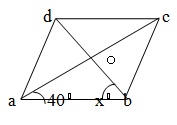
- Aptitude - Home
- Aptitude - Overview
- Quantitative Aptitude
Geometry - Online Quiz
Following quiz provides Multiple Choice Questions (MCQs) related to Geometry. You will have to read all the given answers and click over the correct answer. If you are not sure about the answer then you can check the answer using Show Answer button. You can use Next Quiz button to check new set of questions in the quiz.

Q 1 - In the given figure , ∠POS = 90⁰. What Is the measure of ∠ROQ?

Answer : C
Explanation
∠ROQ = ∠POS (vert. opp. ∠s) = 90⁰.
Q 2 - Two angles are complementary, if the sum of their measures is
Answer : A
Explanation
Two angle are complementary, if the sum of their measures is 90⁰.
Q 3 - In the given figure , AB || CD, ∠ABE =35⁰, ∠CDE = 65⁰ and ∠BED =x⁰. Then, x= ?
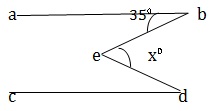
Answer : B
Explanation
Draw GEH ||AB||CD. ∠ BHE =∠ ABE = 35⁰ (alt .∠s) ∠ DEH =∠ CDE = 65⁰ (alt .∠s) ∴∠x=∠ BEH + ∠DEH = (35⁰ +65⁰)=100⁰.

Answer : C
Explanation
let 2∠ A = 3∠B = 6∠ C=ℏ. Then ∠A = ℏ/2 , ∠ B = ℏ/3 and ∠ C =ℏ/6 But , ∠ A+∠B+∠C = 180⁰ ∴ ℏ/2 + ℏ/3+ ℏ/6 = 180 ⇒ 3 ℏ+2 ℏ+ ℏ = 180*6 ⇒ 6 ℏ =180*6 ⇒ ℏ=180 ⇒ ∠B = 180/3 =60⁰
Answer : B
Explanation
∠ A- ∠B = 33⁰ and ∠B -∠C =18⁰ ⇒ A= 33+ B and C=B -18 = (33+B) + B + (B-18) =180 ⇒ 3B =165 ⇒ B 55. ∴ ∠B =55⁰.
Q 6 - Two poles of heights 6m and 11m stand vertically on a plane ground. If the distance between their feet is 12m , what is the distance between their tops?
Answer : A
Explanation
Let AB and CD be the poles such that AB = 6m , CD = 11 m and BD =12m Draw AE ⊥ CD . Then , AE = BD = 12m CE = CD - DE = CD - AB = (11 - 6) m =5m. from right AEC we have AC2 = AE2 + CE2 = (12)2 + 52 = (114 +25)=169 ⇒ Ac = √169 = 13m ∴ Distance between their tops= 13m
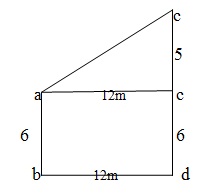
Q 7 - A chord of length 30cm is at a distance of 8cm from the center of a circle . The radius of the circle is
Answer : D
Explanation
Let O be the centre of the circle and AB be the chord. Draw OL ⊥ AB. Then AL= 1/2 AB = (1/2 *30)cm =15 cm and OL = 8cm. OA2 = OL2 +AL2= 82 + (15)2 = (64 + 225 ) =289 ⇒ OA = √289 = 17cm. ∴ Radius of the circle is 17 cm.
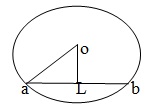
Q 8 - In the given figure , POQ is a diameter and PQRS is a cyclic quadrilateral. If ∠PSR =130⁰, Then ∠ RPQ =?

Answer : A
Explanation
PQRS is a cyclic quadrilateral. ∠PSR + ∠PQR = 180⁰ ⇒ 130⁰ + ∠PQR =180⁰⇒∠ PQR=50⁰. Also PRQ = 90⁰ (angle in a semi- circle) In PQR we have ∠PQR + ∠PRQ + ∠RPQ = 180⁰⇒ 50⁰ +90⁰+∠RPQ =180⁰ ⇒ ∠RPQ = 40⁰.
Q 9 - In the given figure, chords AB and CD of a circle intersect externally at P. If AB =6cm, CD = 3cm and PD= 5cm then PB= ?
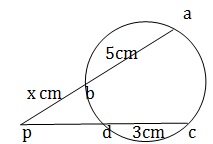
Answer : D
Explanation
PA * PB + PC *PD ⇒ (x+6 ) * x=8* 5 ⇒ x2 +6x - 40 =0 ⇒ (x+10) (x-4) =0 ⇒ x=4 ∴ PB= 4 cm
Q 10 - In The adjoining figure, ABCD is a rhombus whose diagonals intersect at O. IF ∠OAB =40⁰ and ∠ABO =x⁰, then X= ?
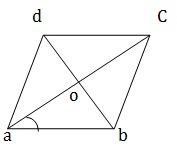
Answer : A
Explanation
We know that the diagonals of a rhombus bisect each other at right angle . So ,∠ AOB = 90⁰. Now ,∠ OAB + ∠ABO + ∠AOB = 180⁰ ⇒ 40 +x + 90 = 180 ⇒ x=50.
